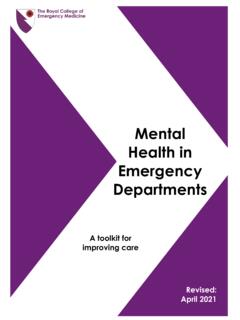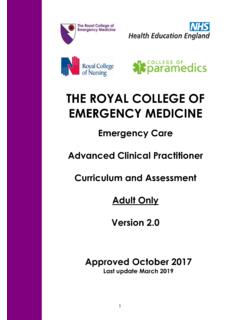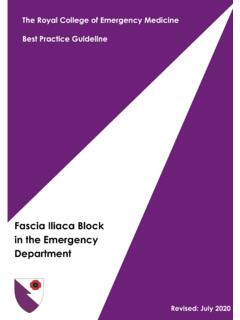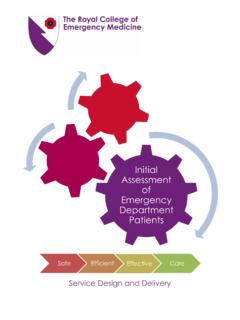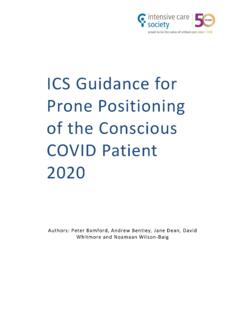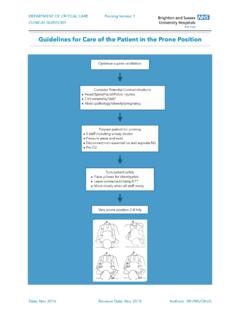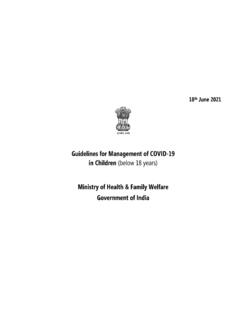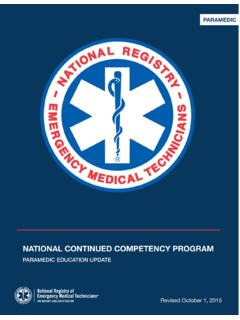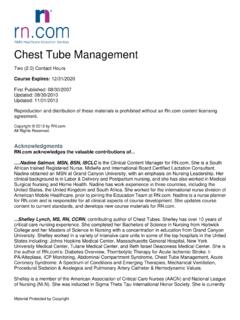Transcription of Guidelines for the Management of Excited Delirium / Acute ...
1 The Royal College of Emergency Medicine Best Practice Guideline Guidelines for the Management of Excited Delirium / Acute Behavioural Disturbance (ABD) May 2016 Guidelines for the Management of Excited Delirium / Acute Behavioural Disturbance (ABD) 2 Summary of recommendations 1. RCEM publications must have been subject to the review and approval processes as described within the Terms of Reference of the relevant committee, including peer and lay review. 2. Excited Delirium / Acute Behavioural Disturbance (ABD)1 is a medical emergency affected individuals may suffer sudden cardiovascular collapse and/or cardiac arrest with little or no warning. 3. Patient restraint time in ABD should be kept to an absolute minimum - the degree of restraint used must be justifiable, reasonable, for the minimum time necessary and proportional to the situation. 4. Sedation should be with intravenous benzodiazepines, antipsychotics or ketamine.
2 If the intravenous route is not immediately available then intramuscular administration should be used. 5. Early and aggressive Management of hyperthermia and acidosis should be instituted and a high index of suspicion for the development of rhabdomyolysis and Disseminated Intravascular Coagulation (DIC) should be maintained. Guidelines for the Management of Excited Delirium / Acute Behavioural Disturbance (ABD) 3 Scope To provide a guideline for Emergency Departments to safely and effectively manage adults who attend with Excited Delirium / Acute Behavioural Disturbance (ABD). Reason for development The National Institute for Clinical Excellence (NICE) have developed Guidelines entitled Violence and aggression: short term Management in mental health, health and community settings 1. The NICE Guidelines focus on prevention, recognition and reducing the risk of violence, but does not deal in detail with Excited Delirium / ABD which is a very specific presentation of violence and aggression carrying significant clinical risk.
3 Introduction Acute Behavioural Disturbance (ABD) is the accepted terminology adopted by the UK Police Forces, the Ambulance Services and the Faculty of Forensic and Legal Medicine2. It describes the sudden onset of aggressive and violent behaviour and autonomic dysfunction, typically in the setting of Acute on chronic drug abuse or serious mental illness. However, there is not yet a common standardised definition and its incidence has not been clearly quantified. ABD, or as it is also known Excited Delirium , is the presentation of features of Acute Delirium and hyper-adrenergic autonomic dysfunction and must be considered a medical emergency. Its presentation is associated with sudden death in approximately 10% of cases3. High profile deaths of individuals displaying features of ABD have occurred whilst they have been in police custody. This has attracted much media coverage and ABD has become a controversial and emotive illness with significant distress to families involved.
4 The early recognition, intervention and proactive treatment of ABD, with a collaborative response between the Emergency Services (police, paramedics), is likely to result in fewer deaths. Individuals with ABD most often come into contact with the police initially as they are called to attend due to the individual s sudden onset of bizarre, aggressive and violent behaviour. The presenting behaviour can range Guidelines for the Management of Excited Delirium / Acute Behavioural Disturbance (ABD) 4 from mildly erratic to a state of extreme agitation and physical exertion. Patients have signs of hyper-adrenergic autonomic dysfunction such as significant tachycardia, marked metabolic acidosis and hyperthermia and these are associated with multi organ failure and The identification of ABD can be challenging clinically as the spectrum of behaviours and signs overlap with many other disease presentations and there is no definitive diagnostic test.
5 ABD appears to be more common when the weather is warm and humid and deaths more commonly occur in the summer months4. Fatalities in ABD typically occur in men in their mid-thirties who have a history of stimulant drug abuse, usually cocaine6. Currently the pathophysiology of ABD is not well understood but it is likely to be multi-factorial; furthermore, an individual s pre-disposition to a fatal outcome is also poorly understood. Box 1: Physical symptoms and signs typical of ABD Extremely aggressive/violent behaviour Excessive strength/continued struggle despite restraint Insensitive to pain Acute psychosis with fear of impending doom Constant physical activity without fatigue Hot to touch/profusely sweating/inappropriate state of undress Hyperthermia Tachypnoea Tachycardia Differential Diagnoses of ABD Heat Stroke Neuroleptic Malignant Syndrome Serotonin Syndrome Thyroid Storm Sepsis Substance intoxication / withdrawal Hypoxia Hypoglycaemia Head Injury / Seizures Akathisia Guidelines for the Management of Excited Delirium / Acute Behavioural Disturbance (ABD) 5 Many factors have been proposed as contributory to causes of sudden death in ABD such as positional asphyxia secondary to restraint technique, drug toxicity and underlying cardiac disease associated with cardiac arrhythmias.
6 The severe metabolic acidosis associated with ABD is a likely contributing factor in cardiovascular collapse and death7. ED physicians must be able to recognise that the presenting signs and symptoms in ABD represent a medical emergency. Management The initial aim of Management of an individual with ABD should be the rapid tranquilisation and minimisation of their hyper-exertional state. Sedation and de-escalation is of paramount importance in ABD this reduces the risk of harm to the individual and all involved with their care and enables a full medical assessment to begin with the prompt institution of supportive Management . 1. Restraint Verbal calming and de-escalation techniques maybe be used as the first line intervention in attempting to manage individuals displaying ABD. However, these patients are often highly agitated and aggressive with an altered mental status making their response to de-escalation techniques unpredictable.
7 Physical restraint to facilitate their initial Management may be inevitable. This should be kept to a minimum using a level of force that is justifiable, reasonable and proportional to the individual case and rapidly followed by sedation with close monitoring of vital signs1. Physical or manual restraint should be viewed as an intervention of almost last resort prior to providing definitive chemical restraint / rapid tranquilisation; prolonged physical restraint must be avoided. Physical restraint has been associated with injuries to patients as well been a contributing factor in patient deaths and particular care must be exercised to ensure that at no time the patient s airway is compromised, this is particularly likely if the patient is kept in a face down position ( due to spitting or biting) with pressure applied on the patient s neck or shoulder Guidelines for the Management of Excited Delirium / Acute Behavioural Disturbance (ABD) 6 region.
8 Keeping the patient in a prone position MUST be avoided. It should further be remembered that significant physiological derangements (acidosis, electrolyte abnormalities, cardiac arrhythmias etc.) can occur due to the underlying condition (eg. Excited Delirium ) or as a result of resisting restraint and may be exacerbated by comorbidities (eg. cardiac disease) or medication / illicit substances. If a patient is being restrained in the Emergency Department, even if the police are providing this intervention, ultimate responsibility for the patient s safety and well-being rests with the doctors and nurses of the emergency department. There is insufficient research on the effects of TASER on ABD however its use as a rapid takedown method to minimise restraint time and activity and allowing expeditious medical intervention may be a necessary alternative once nonphysical methods have failed. 2. Sedation Sedation (rapid tranquilisation) will be required to facilitate rapid intervention and institution of potentially lifesaving treatments if an individual displaying ABD fails to respond to de-escalation techniques.
9 The rapid control and calming of an individual displaying the extreme physical exertion associated with ABD is essential to prevent further worsening of their metabolic status3. Ideally sedation should be administered via the intravenous route however this route is unlikely to be immediately available. The clinician must therefore make a decision regarding the safety of the patient (minimizing duration of restraint) and team (avoiding both physical and needlestick injury) as to whether it is better to attempt cannulation (accepting the difficulty of the procedure in an uncooperative patient) or whether to administer an intramuscular agent of sufficient strength to allow rapid control of the patient followed by cannulation and monitoring in a high dependency area. It is important to remember that the absorption of IM medication can occur far more rapidly when an individual is agitated or physically overactive.
10 It should also be remembered that individuals displaying ABD may well need much higher doses of sedative agents than are typically required or recommended12. Guidelines for the Management of Excited Delirium / Acute Behavioural Disturbance (ABD) 7 There are currently three groups of agent used for sedation in ABD - benzodiazepines, antipsychotics and ketamine (see appendix 2). However, there is a paucity of high quality evidence in the medical literature to determine the most suitable single agent or combination of agents. a. Benzodiazepines are the most commonly used sedative agents in the ED and are familiar to all ED physicians. They generally have a wide safety profile and have multiple routes of administration. However, there is variability in the dose response relationship between individual patients and this often necessitates active titration this may be undesirable in ABD where rapid and predictable sedation is essential.
